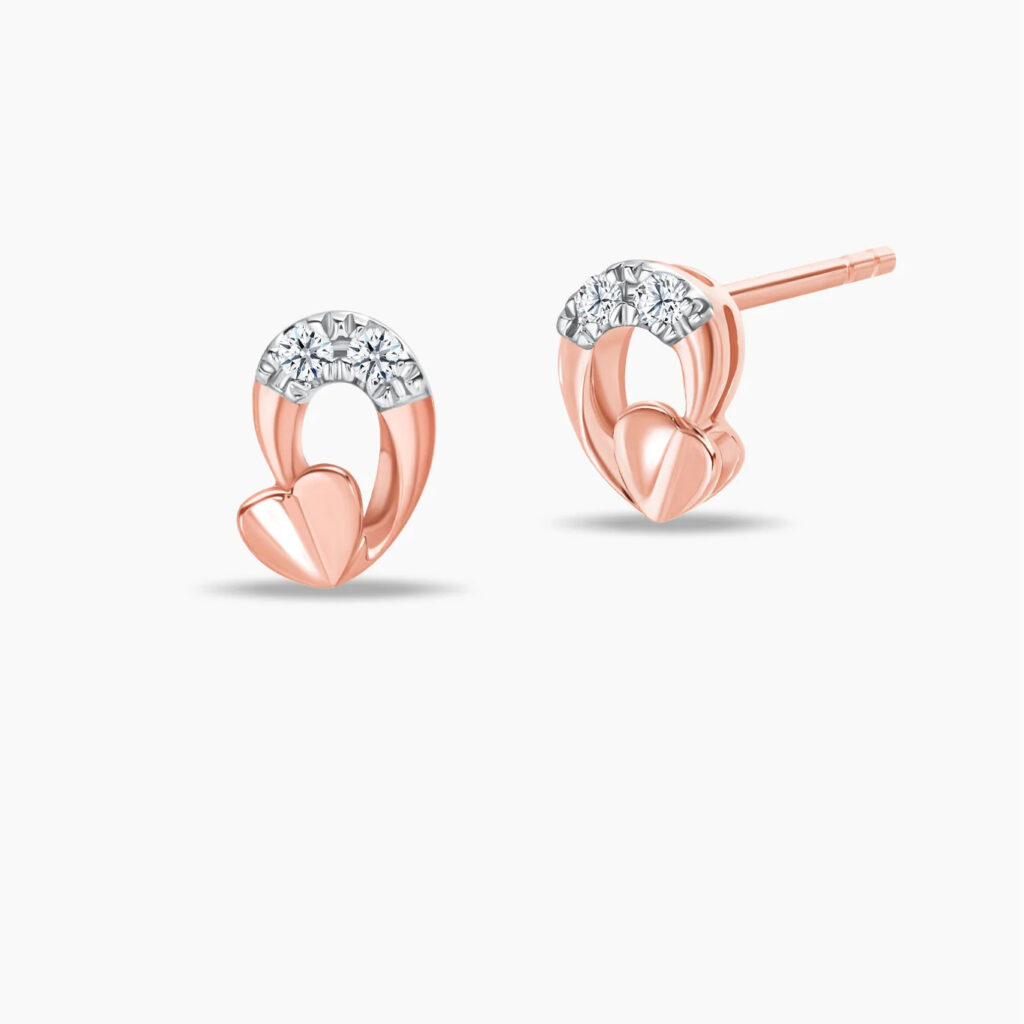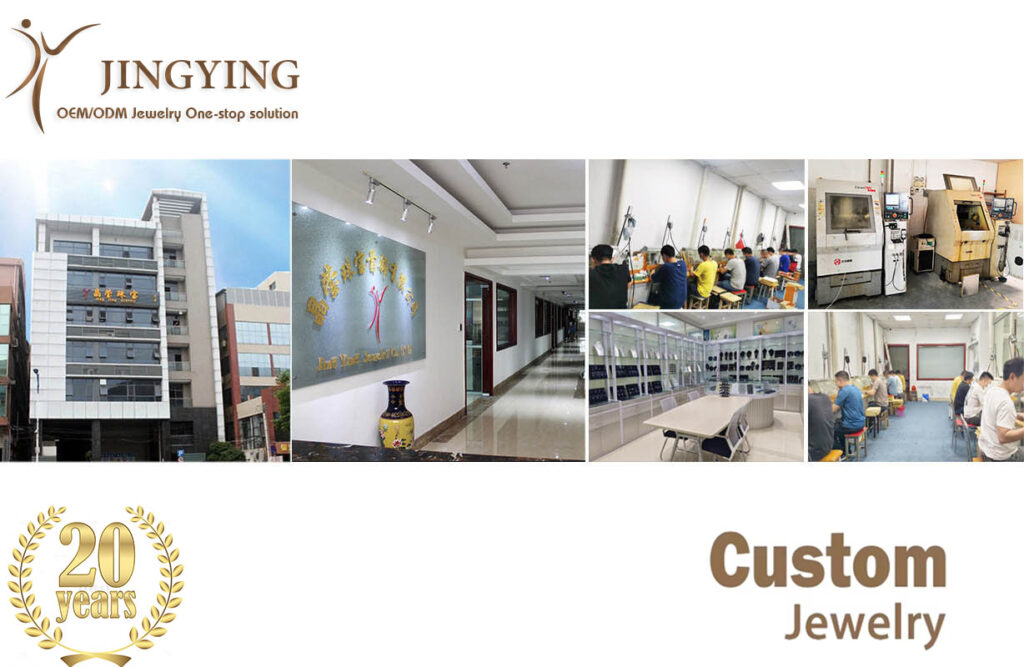Crearea unei bijuterii este o alchimie captivantă, a journey that transforms raw, unrefined materials into an object of beauty, sentiment, și exprimarea personală. When that piece is a pair of rose gold heart-shaped earrings, the process carries an added layer of meaning, blending the universal symbol of love with the warm, contemporary elegance of one of the most beloved jewelry metals. The journey from a concept to a finished product adorning someone’s ears is a fascinating tale of artistry, inginerie de precizie, and meticulous craftsmanship.

This process can be undertaken on two vastly different scales: the intimate, hands-on approach of an artisan jeweler at their bench, and the streamlined, technologically advanced operation of a large-scale manufacturer like Jingying, a leader in custom jewelry production. This article will provide a complete, behind-the-scenes exploration of both pathways, detailing every step involved in bringing a pair of rose gold heart-shaped earrings to life.

Parte 1: Fundația – Understanding Rose Gold
Before the first sketch is drawn or the first metal is melted, it is crucial to understand the material itself. “Aur roz” is not a pure elemental metal but a beautiful and durable alloy.
-
The Composition: Aur pur, known as 24-karat gold, is too soft for practical jewelry use. To give it strength and color, it is alloyed with other metals. The distinctive pinkish-red hue of rose gold comes from a high copper content. A typical alloy for 14K rose gold is 58.5% aur pur, cu restul 41.5% being primarily copper and a small amount of silver to temper the red color and enhance workability. 18K aur roz (75% aur pur) will have a richer, less pink color due to the higher gold content.
-
The “Filled” vs. “Plated” Distinction: For earrings, which are subject to sweat and wear, the method of applying rose gold is critical for longevity.
-
Placat cu aur roz: A very thin layer (often less than 0.5 microni) of rose gold is electroplated onto a base metal (de obicei alamă). This coating is inexpensive but can wear off quickly, exposing the base metal beneath.
-
Umplut cu aur roz: This is a far superior method. A thick layer of rose gold (constituting at least 5% of the item’s total weight) is mechanically bonded to a core of jewelers’ brass under immense heat and pressure. This creates a durable, long-lasting product that is highly tarnish-resistant and hypoallergenic, offering the look and feel of solid gold at a more accessible price point. This is the standard for quality fashion and semi-fine jewelry.
-
Solid Rose Gold: The entire piece is made from the rose gold alloy. This is the most expensive and luxurious option.
-
The process described below will focus on the creation of both solid and gold-filled heart-shaped earrings, as the fundamental shaping and assembly processes are similar, differing primarily in the initial metal selection and the bonding process for filled material.
Parte 2: The Two Pathways of Creation
The journey of a heart-shaped earring can follow one of two primary routes: hand fabrication şi casting. The choice depends on the desired outcome, volum, and complexity.
-
Method A: Fabricare manuală (The Artisan’s Approach) This is the process of creating a one-of-a-kind or limited-edition piece directly from sheet metal and wire using hand tools. It’s ideal for unique designs, prototypes, or a deeply personal creative experience.
-
Method B: Casting (The Manufacturing & Small-Batch Approach) This involves creating a model and then using it to form a mold. Molten metal is then poured into this mold to create the earring components. This is the method used by manufacturers like Jingying to produce consistent, high-quality pieces in any quantity, from a dozen to tens of thousands. It is also the only feasible method for creating solid gold earrings with complex details.
We will explore both pathways in detail.
Pathway A: The Art of Hand Fabrication
This pathway is a meditation in precision, performed at the jeweler’s bench.
Pas 1: Design și conceptualizare
The process begins with an idea. The designer decides on the style: Will it be a classic, symmetrical heart? A modern, geometric interpretation? A pair of interlocking hearts? Does it feature a cut-out design or a textured surface? Sketches are made, and dimensions are finalized, considering weight and comfort for the ear.
Pas 2: Selectarea și pregătirea materialelor
The jeweler selects a sheet of rose gold (solid or the base brass for later filling) of an appropriate thickness (de obicei 18-20 gauge for earrings). The sheet is annealed (heated with a torch to soften it) to make it easier to work with.
Pas 3: Transferring the Design
The heart design is printed or drawn on paper and glued onto the metal sheet. Using a scribe, the jeweler firmly traces the outline, scratching the design onto the metal surface below.
Pas 4: Tăind formularul
-
Instrumente: Cadrul de ferăstrău al bijutierului și lamele de ferăstrău ultra-fine (De ex., 2/0 sau 3/0).
-
Proces: The metal sheet is secured to a bench pin. The saw blade is threaded into the frame with teeth pointing downward. The jeweler carefully follows the scribed line, using a steady, up-and-down motion to saw out the heart shape. For pierced designs (hearts with holes in the center), a small pilot hole is drilled first to thread the saw blade through.
Pas 5: Depunerea și rafinarea
The rough-sawn edges are smoothed and refined using a set of needle files (plat, jumătate de rundă, rundă). This step defines the final contour of the heart and removes all saw marks.
Pas 6: Șlefuire și pre-lustruire
Using sandpaper or abrasive pads in progressively finer grits (din 220 la 1200 grit), the jeweler sands the heart, removing all file marks and creating a smooth, uniform surface ready for final polishing.
Pas 7: Creating the Earring Components
A heart-shaped earring is rarely just a heart. It requires other parts:
-
Posts and Backs: For stud earrings, a post must be soldered to the back of the heart. The jeweler files a flat spot on the heart, prepares a pre-made post and clutch, and uses a torch and hard solder to attach it securely.
-
Hooks: For dangle earrings, a jump ring or a soldered loop must be created at the top of the heart. The jeweler may also hand-forge a French hook or shepherd’s hook finding from rose gold wire.
Pas 8: The Gold Filling Process (If applicable)
If the jeweler is working with brass, the shaped hearts are now sent to a specialized facility for the gold filling process. The components are placed in a rolling mill with a sheet of solid rose gold alloy on top. Under extreme heat and pressure, the two metals are permanently bonded together into a single sheet, care este apoi atras de grosimea dorită finală. Inimile pre-formate sunt apoi tăiate din această nouă foaie plină de aur.
Pas 9: Lustruire finală
Folosind un instrument rotativ cu roți de tamponare muselină și compuși de lustruire (Tripoli pentru tăiere, Rouge pentru o strălucire mare), bijutierul lustruiește inima la un genial, Finisaj oglindă.
Pas 10: Adăugarea unei patine și a unui ansamblu final (Opțional)
Pentru a accentua detaliile, Un oxidant precum ficatul de sulf poate fi aplicat pentru a întuneca piesa. Punctele înalte sunt apoi lustruite înapoi, Lăsând adâncurile întunecate pentru contrast. În cele din urmă, Toate componentele sunt asamblate (De ex., atașând cârligul la inimă printr -un inel de salt).
Calea b: Precizia turnării (Metoda Jingying)
Pentru producerea mai multor perechi sau modele identice cu detalii 3D complexe, Castrarea este standardul industriei. Acesta este procesul perfecționat de producătorii de volum mare.
Pas 1: Design digital și modelare CAD
În loc de o schiță de mână, Un designer folosește un design asistat de computer (CAD) software pentru a crea un model 3D precis al cerceiului în formă de inimă. Acest lucru permite o simetrie perfectă, Modele de suprafață complexe, și optimizare pentru turnare. La Jingying, Proiectanții CAD lucrează îndeaproape cu clienții pentru a transforma conceptele în fișiere digitale producătoare.
Pas 2: 3D tipărire (Prototiparea rapidă)
Fișierul CAD digital este trimis la o imprimantă 3D de înaltă rezoluție. Imprimanta construiește stratul de model prin strat dintr -o ceară specială de turnare sau rășină. Acest lucru creează un prototip fizic perfect al cercelului inimii, Adesea cu sprue (un canal pentru metalul topit) deja atașat.
Pas 3: Fabricarea mucegaiului
Modelul de ceară este transportat la o ceară centrală “copac” with dozens of other identical models to maximize production efficiency. This tree is placed inside a steel flask, și o tencuială de investiții lichide este turnată în jurul ei. The plaster sets into a hard, heat-resistant mold.
Pas 4: Ardere și turnare
-
Burnout: Balonul este plasat într -un cuptor, and the wax inside is melted and “pierdut,” leaving a perfect hollow cavity in the shape of the earrings.
-
Casting: The flask is removed from the kiln while still hot and placed in a vacuum or centrifugal casting machine. Pre-measured rose gold alloy (or brass for filling) is melted in a crucible and then forced into the hollow cavity, filling every microscopic detail.
Pas 5: Devesting, Tăiere, and Cleaning
Odată răcit, Mucegaiul din ipsos este stins în apă, breaking it away from the metal tree. The rough, sprue-covered earrings are cut from the tree. Apoi sunt căzute într -un tumbler magnetic cu oțel pentru a îndepărta orice investiție rămasă și a netezi suprafețele.
Pas 6: The Gold Filling Process (If applicable)
Dacă piesele turnate sunt în alamă, Acum suferă procesul mecanic de umplere a aurului. Componentele sunt plasate într -o cameră în care sunt bombardate cu ioni pozitivi de aur de trandafir în vid, un proces numit depunere de vapori fizici (PVD), sau sunt electroplați cu un strat excepțional de gros de aur de trandafir pentru a îndeplini standardele umplute.
Pas 7: Finisare și lustruire
Acesta este un proces în mai multe etape:
-
Tumbling: Piesele sunt căzute cu medii mai fine pentru pre-lustruire.
-
Confecţie manuală: Muncitorii pricepuți depun orice porți rămase de casting și șlefuiesc piesele.
-
Lustruire: Cerceii sunt lustruiți pe roți motorizate cu compuși de lustruire pentru a obține finisajul specificat (Polisul înalt, satin, Matte).
Pas 8: Control riguros al calității (QC)
This is a critical step at Jingying. Every single earring is inspected.
-
Dimensional Accuracy: Checked against the CAD model.
-
Surface Quality: Inspected for pits, zgârieturi, sau urme de lustruire.
-
Gold Layer Integrity: For filled pieces, the thickness is verified.
-
Funcționalitate: Posts are checked for straightness, and backs and hooks are tested for security.
Pas 9: Asamblare, Ambalaj, and Logistics
Earring posts are fitted with hypoallergenic friction backs or clutch backs. Dangle earrings are assembled with secure jump rings. The finished pairs are ultrasonically cleaned, placed in branded packaging, și pregătit pentru expediere globală.
Concluzie: The Alchemy of Love and Craft
The process of making rose gold heart-shaped earrings is a remarkable fusion of ancient art and modern science. Whether created through the focused skill of an artisan who saws and files each curve by hand, sau prin baletul orchestrat tehnologic al unei fabrici moderne, Rezultatul este un obiect care poartă mai mult decât o simplă valoare estetică.
Poartă intenția designului său, Precizia ingineriei sale, și diligența măiestriei sale. O pereche de cercei cu inimă de aur trandafir nu este doar un accesoriu; Este un testament al creativității umane și al dorinței noastre durabile de a da o formă tangibilă emoțiilor noastre cele mai prețuite. De la o grămadă de metal la un simbol al afecțiunii, Călătoria creației lor este o poveste la fel de frumoasă ca produsul finit în sine.
